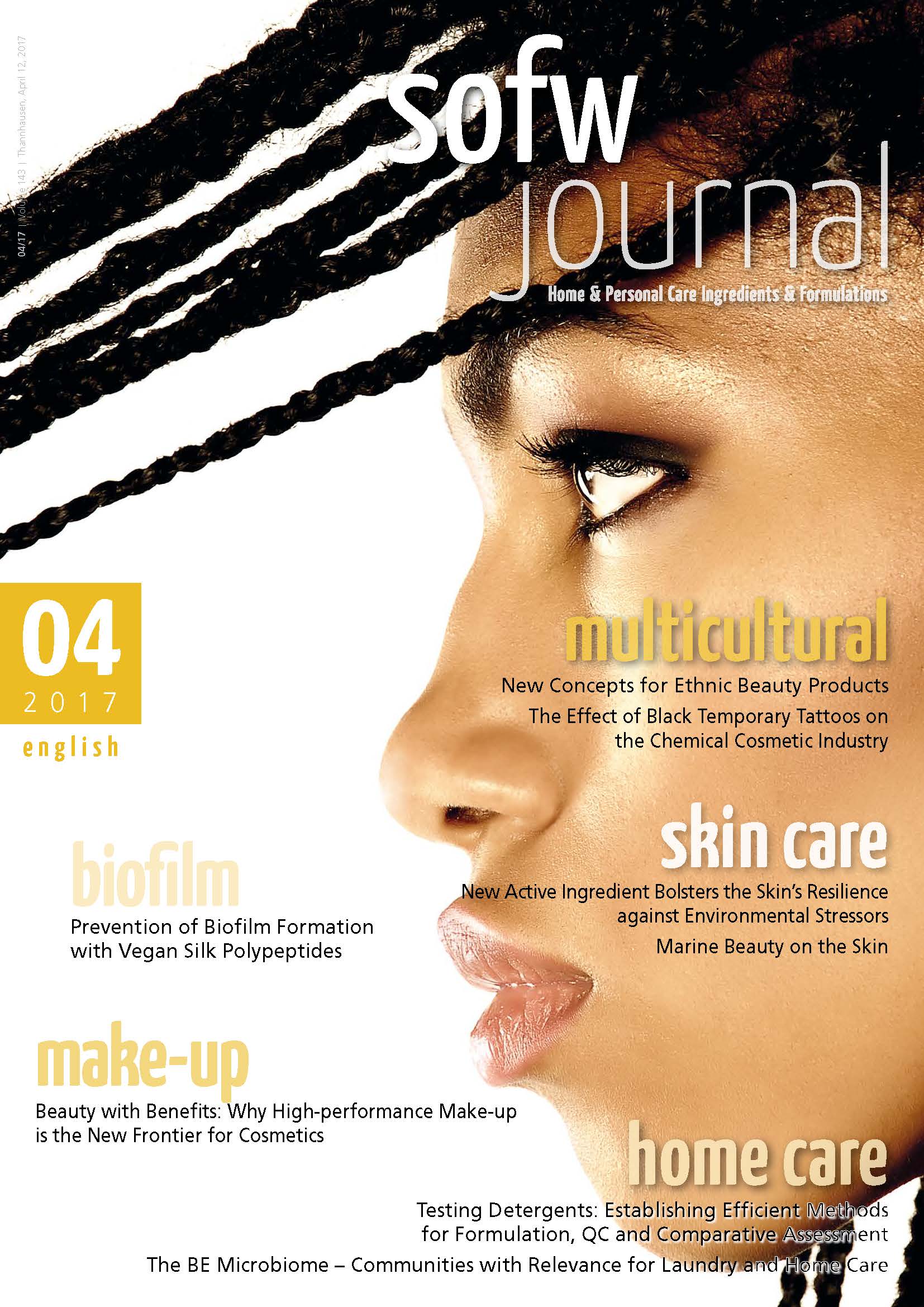Introduction
The Hair Tensegrity: applying an architecture-inspired concept to hair care
The hair structure is a unit where hair scalp, follicle and shaft must be considered as a whole [1,2]. Scalp is the hidden essential in hair biology and is responsible for the nourishing, biology, and mechanical behaviours of the pilosebaceous unit (Figure 1). Therefore, all the parts of hair are interconnected and the whole hair system can be revitalized based on the new concept of hair tensegrity.
The term “tensegrity” comes from architecture and is coined from the contraction of the terms “tensional” and “integrity” (components of any structure which are under compression while they are inside a network in continuous tension) [3]. The Tensegrity explains how changes applied to an area of a given structure will also exert effects at a distance because everything is interconnected.
For instance, a skyscraper must have a good tensegrity (being strong enough, but also flexible enough to resist the wind at high altitude). Following this analogy, a healthy hair must have a good tensegrity (being strong enough, but also flexible enough to be manageable, soft, easy to comb, and maintaining its natural movement).
This integral vision of tensegrity has been thus transferred to the hair structure, launching the new cosmetic approach of TrichoTensegrity, i.e., hair tensegrity. It appeals to the importance of the scalp and the hair structure and its influence on hair mechanical properties
and biological behavior. The hair shaft and the scalp are intimately interconnected as a continuum, and each part is interdependent from the other.
Because everything is interconnected (cells, tissue and extracellular space) the evolution of the multifunctionality is envisaged. Biotensegrity [4] emerges as the evolution of multifunctional, where it is possible to exert a holistic effect in the complete structure by affecting its individual parts.
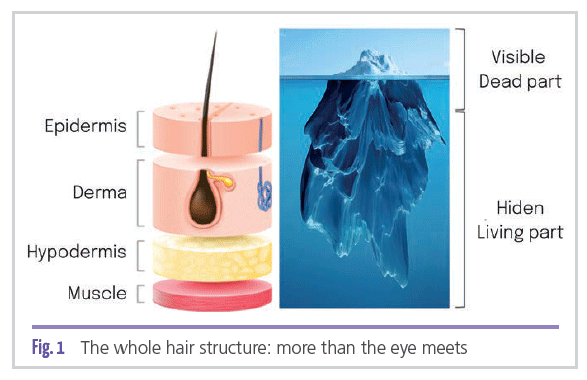
Elements of Trichotensegrity
Scalp is essential for a healthy hair [5,6]. The relationship between scalp conditions and changes in composition of the emerging hair, the cuticle, capillary fragility, lack of shine, among others, has been clearly established. The scalp anchors and supports the hair follicles, providing the necessary environment for the formation of healthy hair fibers.
For the maintenance of capillary tensegrity, it is essential that the scalp and the follicle remain compact, elastic, and firm. This scalp-follicle-shaft continuum is built from the interaction of the cells (keratinocytes, fibroblasts, epithelial cells of the hair follicle, germ cells, and trichocytes), and the extracellular matrix.
The follicle is surrounded by a layer of fibrous connective tissue that links it directly with the dermis. These elements, connected to each other, contribute to the adequate hair formation and cohesion. In the follicle core, the matrix cells or germ cells (GC) divide and differentiate in each concentric layer. The more outside they are, the more keratinized they get, finally becoming trichocytes. This process is analogous to the differentiation of epidermal keratinocytes into corneocytes.
During the maturation of trichocytes, interlinked keratin filaments are produced and packaged to form a biomaterial that emerges to the outside to fulfill its protective and aesthetic functions [7,8]. The viscoelastic properties of the resulting material are based on three types of structural elements that act together:
- A NETWORK OF FIBROUS PROTEINS: Keratin Intermediate Filaments, which act as support elements to stabilize tension or torsion.
- A NETWORK OF ANCHORING PROTEINS: Versican and Collagen XVII, which provide a structural binding support in the Extracellular Matrix (ECM).
- A SYSTEM OF INTERCELLULAR MATRICES: Cell Membrane Complex (CMC), which interconnects the fiber network through the hair shaft.
During the differentiation, cells produce keratin filaments that fill the intracellular space. Furthermore, hair anchoring proteins like Versican and Collagen XVII maintain the tissue cohesion. Finally, certain cellular components are selectively transformed into structural elements of the stem, including the cell membranes that form the Cell Membrane Complex (CMC).
Versican is a key proteoglycan for the ECM structure and the follicular architecture. Its peculiar composition allows it to anchor simultaneously to different structures and act as a molecular bridge between cells and extracellular matrix, thus increasing the tissue cohesion. Present in the dermis, in the active dermal papilla and the outer sheath cells (ORS), it is essential for a normal hair growth. The Versican levels vary during the hair cycle, being its maximum expression during the anagen phase, in which it has a fundamental role in the induction and maintenance of this hair growing phase [9,10,11].
Collagen XVII is a special type of collagen which is a transmembrane protein that acts as an anchor to the follicle cells and is essential for the capacity of self-renewal and prevention of follicle aging. Anchoring the hair follicle stem cells (the dermal papilla cells), it is critical for the hair follicle self-renewal and for the prevention of the hair follicle ageing [8,12,13].
The CMCs constitute the intercellular matter in the hair that unites the fibers and provides integrity to the tissue by joining the cell membranes between the different hair cells (between cortical, cortical-cuticular, and cuticular cells). They are laminar structures composed of lipids and membrane structural proteins [14].
Therefore, the scalp, the follicle and the hair shaft are all interconnected and each of their components contribute to hair tensegrity: the cells (keratinocytes, fibroblasts, epithelial cells of the hair follicle, germ cells, and trichocytes), the proteins (keratin, versican, and collagen XVII) and the lipids (the CMC).
An Encapsulated Cellular Oil (Eco) Approach to Hair Tensegrity
ELAYA RENOVA™ (Figure 2) is an active ingredient based on the wild olive tree sprouts, that is Olea europaea var. sylvestris from the Mediterranean ecosystem. It is an ancestral Mediterranean species.
The wild olive tree is the native olive variety and is the predecessor of all the olive oil trees varieties currently used for the industrial production of olive oil. It differs from the tamed species by its shrub aspect, by its thorns in its branches, by its more rounded leaves and its smaller fruits.
The three main characteristics of the plant are: Resilience, Vitality and Longevity. Three aspects that ELAYA RENOVA™

brings, for the first time, to the hair care. Thanks to ELAYA RENOVA™ ’s Encapsulated Cellular Oil (ECO) approach, it is possible to concentrate the three properties in one single hair care active ingredient.
Following the latest advances in the Vytrus Biotech Technology Platform, here we present a new generation of Phyto-Lipidic Fractions, specially designed for its use as structural strengthener of hair and scalp following the tensegrity principles: the first Encapsulated Cellular Oil (ECO).
Through a driven growth factor control development process, it has been possible to identify, produce and release unique structural lipid fractions (glycolipids and phospholipids) and structural membrane proteins (lipoproteins, glycoproteins, and other transmembrane proteins) from the inside of plant stem cell membranes (Figure 3).
This ECO has a unique lipo-protein composition, analogous of the hair and scalp structural identities that will work synergistically, and it has been demonstrated that it reinforces the hair and scalp tensegrity through a triple axis of action (Figure 4):
- PROTECTING FROM DETERIORATION
- REFILLING AND REVITALIZING
- RESTRUCTURING TO ENHANCE BEAUTY
Among the most active and effective molecules in the wild olive cell cultures for hair care application, a new version of the Phyto-Lipidic Fractions (PLF) stands out, due to its. However, to make them bioavailable for the hair and the scalp, a new encapsulation technology has been developed obtaining for the first time a biotechnological product with a high specificity for hair and scalp surfaces. The result is ECO: the Encapsulated Cellular Oil, which represents an additional step in VYTRUSBIOTECH plant stem cells technology platform.

The ECO technological approach consists of three mainpoints:
- Obtaining the Phyto-Lipidic Fractions
- Bioprocessing: generation of a proteo-lipidic matrix
- Dynamic encapsulation to obtain the ECO
Biological activity
Several ex vivo and in vitro tests were performed to understand and demonstrate the mechanism of action of the active ingredient.
Ex vivo 1: Protection of hair from UVA- induced oxidation (carbonylation of keratin)
The product’s hair protector effect from UVA-induced carbonylation was measured with a pre-treatment of 10 min with each lotion + 2 min massage, then UV-A (84 J/ cm2), followed by incubation with fluorescent probe which binds carbonyl groups, and by microscope image acquisition. The higher the fluorescence, the more damage is observed on hair.
The active demonstrated to protect the whole hair shaft by 60%, the hair cuticle by 70% and the hair cortex by 54% after only one application of ELAYA RENOVA™, compared to a pre-treatment with placebo lotion (Figure 5).
Ex vivo 2: Hair protection versus high temperatures (230ºC)
Hair straighteners can reach temperatures of up to 230ºC, thus damaging the hair. Compared to placebo pre-treatment, the pre-treatment of hair tresses with ELAYA RENOVA™ for 10 minutes protected the hair cuticle from damage, as observed by Scanning Electron Microscopy (SEM) (Figure 6).
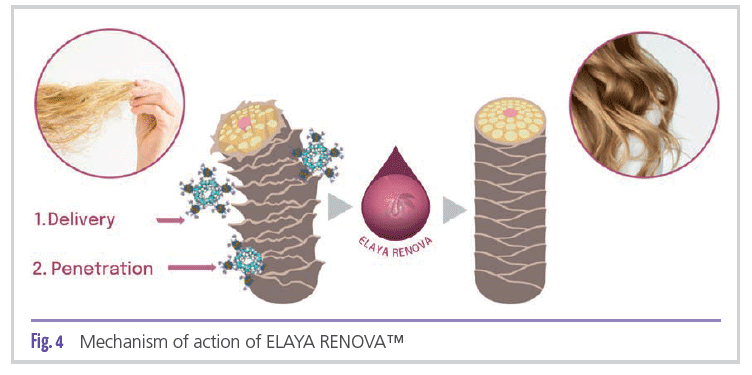
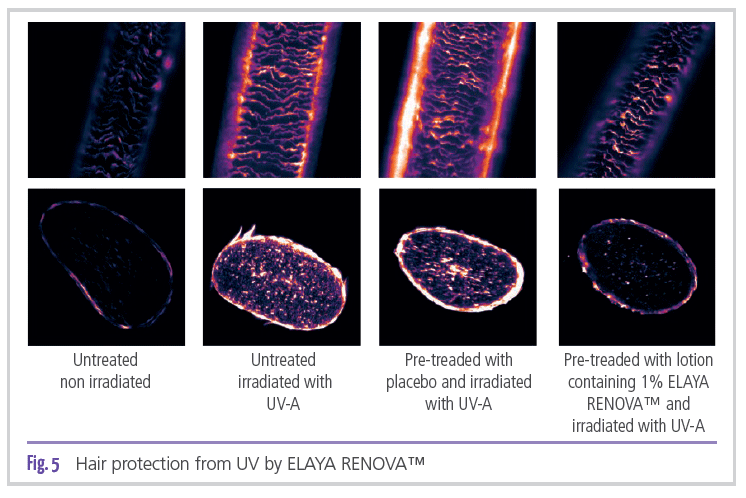
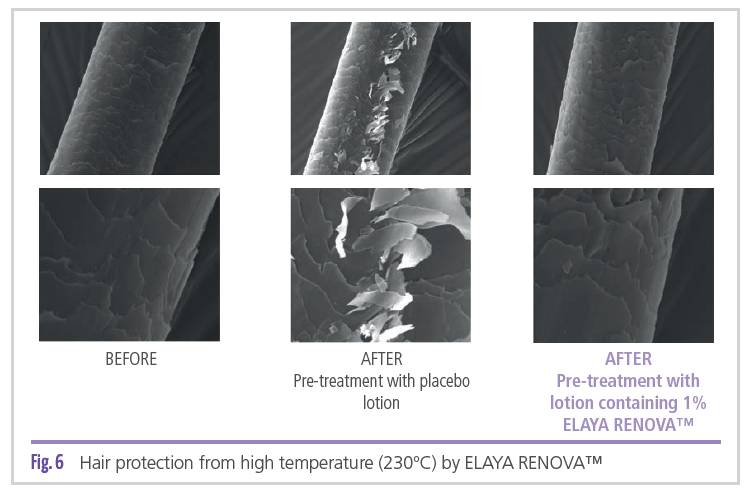
Ex vivo 3: Protection of hair colour in dyed hair (versus placebo lotion)
After 12 washing cycles, digital pictures were taken and analyzed, measuring the luminosity (L*), the red/green channel (a*), the blue/yellow channel (b*), and its variations (L*, a* and b*).
An increase in luminosity (L*) indicates colour loss (lightening), and an increase in colour variation, or colour distance (E*), means an overall colour change. The colour difference is calculated as follows: E* = SQRT ((L*)^2+(a*)^2+(b*)^2).
The tresses were pre-washed with neutral shampoo 1 minute plus 2 minutes rinse-off, and then dried with a hair dryer. A treatment of 10 minutes with each lotion plus a 2-minutes massage followed. After that the tresses were allowed to dry, and then a hair dye was applied, followed by 12 washing cycles, and finally, the colour was measured and compared with the initial colour. The active ingredient prevented the luminosity increase by a 37%, and the colour variation by a 36%.
Ex vivo 4: Hair nourishing (delivery into the hair cortex)
The penetration of ELAYA RENOVA™ into the hair cortex was analyzed by confocal microscopy.
The protocol was based on pre-washing the tresses with
neutral shampoo for 1 minute plus 2 minutes rinse-off. Then the tresses were dried with a hair dryer. Each lotion was mixed with the fluorescent marker BODIPY™ FL C12-Sphingomyelin, which binds lipids, for 10 minutes, followed by a treatment of 10 minutes with each lotion with fluorescent marker plus 2-minutes massage and allowing to dry, and finally, confocal microscope image acquisitions were carried out.
ELAYA RENOVA™ increased the delivery into hair cortex by 3.1-fold versus placebo (Figure 7).
Ex vivo 5: Hair thickness and volume (increase of hair diameter)
The hair diameter was measured by micro-camera before and after treating with a placebo lotion or with a lotion containing 1% ELAYA RENOVA™.
The protocol was based on pre-washing the tresses with neutral shampoo 1 minute plus 2 minutes rinse-off and allowing to dry. Initial hair diameter measurements with the micro-camera were performed, followed by a treatment of 10 minutes with each lotion plus 2-minutes massage and allowing to dry. Finally, measurements of final hair diameter and comparison with initial diameter were carried out. ELAYA RENOVA™ significantly increased the hair diameter by a 14% (9.2 μm), while placebo did not have any measurable effect on hair diameter.
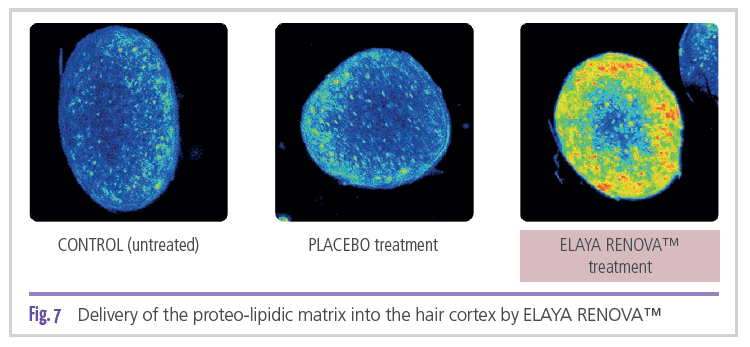
Ex vivo 6: Hair strength increase
The hair strength after heat shock was also evaluated ex vivo. Two groups of 5 tresses each were prewashed with a neutral shampoo for 1 minute at 37ºC, then rinsed with water for 2 minutes and allowed to dry naturally. After that, the initial hair strength was measured, as the maximum force (mN/μm) that each tress could withstand while being stretched before breaking.
Then, 5 tresses were soaked in placebo lotion while 5 other tresses were soaked in a lotion containing 1% ELAYA RENOVA ™, and after that, the tresses were left to dry naturally for 12 hours (leave-on application).
Finally, once the tresses had been allowed to dry naturally, a hair straightener (230ºC) was used on each of the 10 tresses, and then the hair strength was measured again and compared with the initial measurements. ELAYA RENOVA™ significantly increased the hair strength by a 38% vs placebo.
In vitro 1, 2 and 3: Scalp protection (antioxidant effect, anti-glycation activity, and modulation of inflammation and desquamation)
Different assays were carried out to assess the capacity of the product to protect the scalp.
The first one was a DPPH assay to verify the ingredient’s capacity of capturing the free radical 2,2-Diphenyl-1-picrylhydrazyl (DPPH). ELAYA RENOVA™ was able to capture up to an 87% of the DPPH, an activity comparable, and even higher than that of ascorbic acid, the positive control (63% of antioxidant activity).
Then, the capacity of the ingredient for inhibiting the protein glycation reaction was also analysed and compared with the activity of a benchmark, aminoguanidine. The active was able to inhibit the glycation reaction by up to a 51%, an activity comparable, and even a little higher than that of the positive control (47% of glycation inhibition).
Finally, the modulation of Kallikrein-5 (KLK-5) activity was also checked. KLK-5 is a serine protease which amplifies the inflammatory signal, and it is also involved in scalp desquamation. Positively modulating this protease is important for the sensitive scalp, as the inhibition of KLK-5 activity to some extent soothes that type of scalp at the same time it prevents an excessive desquamation. ELAYA RENOVA™ was able to inhibit the glycation reaction by up to a 47%.
In vitro 4 and 5: Scalp reinforcing and regenerating (expression of collagen and proliferation of Human Dermal Fibroblasts, HDF)
Using quantitative RT-PCR (qRT-PCR), the gene expression of Collagen Type III was analysed. This collagen is most abundant on young skin and has the same function as Collagen Type I in adults. Therefore, by boosting Collagen Type III we can see a regenerating effect at the same time as a rejuvenating activity. Compared to untreated HDF, ELAYA RENOVA™ increased the Collagen Type III gene expression by 6-fold, while the positive control, oestradiol, increased the gene expression by 4-fold.
The cellular regenerating effect of the active was demonstrated by the time the proliferation of fibroblasts was boosted by 21% at 0.3% dosage, reaching up to 58% at 1.25% dosage.
All these in vitro and ex vivo assays lead to a very interesting conclusion: the active ingredient has the capacity to protect hair and scalp in front of different aggressions (oxidation, high temperature, excessive inflammatory response, etc.), at the same time it nourishes, reinforces and strengthens hair and scalp (stronger hair, increases hair volume, delivers CMC lipids into the hair cortex, and boosts collagen production and cellular regeneration on scalp). A holistic approach to hair tensegrity.
Clinical evaluation
Several clinical trials evaluated and demonstrated the efficacy of the active ingredient on the volunteers’ hair and scalp appearance.
In vivo 1:
The first in vivo test was performed on a 20-volunteer panel aged 19-70 years old. The study was double-blind and placebo-controlled (half of the volunteers applied the placebo cream and the other half applied the cream containing the active ingredient) applying sprayable leave-on lotions of 15 ml and comparing between before and after 1 or 4 applications, once daily. After each application on dry hair, the lotions were left to act for 24 h (leave-on effect).
The assay was carried out during the pandemic in volunteers with sensitive scalp. Several parameters were analyzed to see the performance of a cream containing the active ingredient at 0.5% dosage. Expert trichologists evaluated different parameters with a scale from 1 to 5, and the average score of each half of the head was compared between the results before the test and after 1 and 4 applications, once daily. After only one application, ELAYA RENOVA™ improved all the average scores corresponding to the analysed parameters (Figure 8).
The tendency continued after 4 applications, where ELAYA RENOVA™ increased the hair volume by 34%, the hydration by 19%, the shine by 27% and the softness by 26%, nearly doubling the performance of the placebo in all these parameters (increase by 20%, 10%, 15% and 13% respectively).
In the same study, the scalp redness was evaluated at the beginning of the assay and after 1 and 4 applications. As the volunteers had sensitive scalp, the initial degree of redness was quite remarkable. The average scalp redness score decreased with placebo after 4 applications, but with ELAYA

RENOVA™ it decreased a 32% more. This could be verified with micro-camera photography, where the active ingredient already reduced the scalp redness on some volunteers after the first application (Figure 9).
In vivo 2:
In another double-blind, placebo-controlled in vivo test, carried out during 28 days on a panel of 15 volunteers, the effect of a lotion containing 1% ELAYA RENOVA™ was analyzed. The lotions were applied twice daily on each half of the volunteer’s scalp. An analysis of the gene expression of two hair anchoring proteins (Versican and Collagen XVIIA), and an evaluation of the scalp TEWL were performed.
As described above, Versican and Collagen XVIIA are two key proteins of the Extracellular Matrix (ECM). Therefore, hair follicle biopsies of 10 volunteers were analyzed by qRT-PCR before starting the assay, and the initial levels of Versican and Collagen XVIIA were compared with those measured at the end of the test.
After studying those results, a clear tendency for ELAYA RENOVA ™ to increase the gene expression Versican and Collagen XVIIA was observed. The placebo lotion decreased the gene expression of Versican by 18% while ELAYA RENOVA™ increased it by 15%. Regarding the Collagen XVIIA expression, placebo increased it by 18% while ELAYA RENOVA™ increased it more intensely, by 34%.
All these results allow to claim, for the first time in cosmetics, that ELAYA RENOVA™ strengthens the anchoring of the hair follicles on the scalp through the stimulation of key anchoring proteins such as Versican and collagen XVII. All this demonstrated in vivo.
Finally, the scalp TEWL was analyzed with a Nano Tewameter® (Courage & Khazaka), both before starting the test and after the 28 days with 2 applications/day on the scalp by the 15 volunteers. The lower the TEWL, the more hydrated the scalp will be. ELAYA RENOVA™ significantly reduced the scalp TEWL at 28d by 15% vs placebo, and by 19% versus initial measurement.
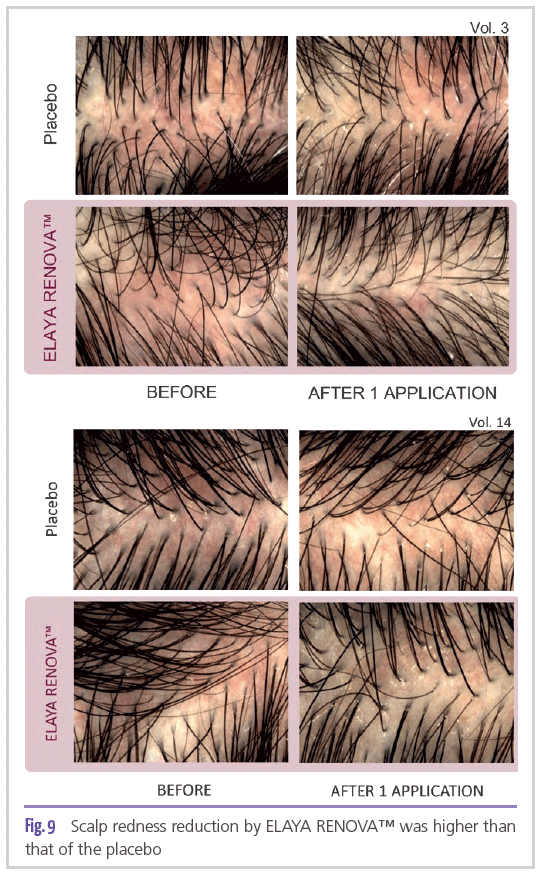
Conclusion
The active ingredient ELAYA RENOVA™, based on the Hair Tensegrity concept, protects and strengthens the whole hair structure, from the scalp to the hair shaft. Specifically enriched in a nourishing proteo-lipidic matrix, it reinforces both the hair and the scalp from the inside.
n scalp it regenerates the fibroblasts, and the ‘young’ Collagen Type III, as well as protecting from oxidative stress and excessive inflammatory response. This is of special interest for soothing the sensitive scalp.
On hair, it gives higher thickness and volume, as well as higher strength, at the same time it protects from damage caused by UV or high temperatures like those achieved with hair straighteners, and it helps maintaining hair colour longer after application of hair dyes.
While opening a new vision for the whole Hair Care market, the active approaches cosmetic applications such as hair care ‘skinification’, hair volumizing and hydrating, as well as hair & scalp care (protection, restructuring, regeneration, revitalizing, reinforcing and in general, beautifying).
This new active ingredient from Olea europaea stem cells brings a paradigm in Cosmetics and a new way for the protection and restructuring of both hair and scalp at the same time. A new path for not having to use different products for each application (hair and scalp, protection and revitalizing), offering the possibility of a multi-activity ingredient to approach all the needs of hair care in one raw material.
Authors
Ò. Expósito, A. Guirado, R. Vallecillo, A. Gallego, M. Mas, P. Riera, D. Luna,
S. Laplana, T. Ruiz, S. Ruiz, M. Gibert, K. Lingen.
Vytrus Biotech S.A. | Barcelona | Spain | [email protected]
References
[1] Manuel Gamez-Garcia. The Cuticle Sheath of Hair: A Functionally Graded Material. Conference: 20th International Hair Science Symposium, Dresden, Germany, September 6-8, 2017.
[2] Yang Yu, et.al. Structure and mechanical behaviour of human hair. Material Science and Engineering C73 (2017) 152-163.
[3] Tensegrity structures and their application to architecture. Valentín Gómez Jáuregui. Tesis de Grado, Univ. Queens. Belfast. Septiembre 2004.
[4] D.E. Ingher, N. Wang, D. Stamenovic. Tensegrity, Cellular biophysics, and the mechanics of living systems. Rep Prog Phys. 2014 Apr;77(4).
[5] Tajran J, Gosman AA. Anatomy, Head and Neck, Scalp. StatPearls Publishing LLC, 2020.
[6] Trüeb RM, Henry JP, Davis MG, Schwartz JR. Scalp Condition Impacts Hair Growth and Retention via Oxidative Stress. Int J Trichology. 2018;10(6):262-270.
[7] Laura Aloso, et. al. Hair cycle. J. Cell Science 119, 391-393, 2006
[8] https://hairskinbodysoul.wordpress.com/2011/04/30/beauty-and-health-102/.
[9] Ji S, Zhu Z, Sun X, Fu X. Functional hair follicle regeneration: an updated review. Signal Transduct Target Ther. 2021 Feb 17;6(1):66.
[10] R.V.Iozzo,“Matrix proteoglycans: from molecular design to cellular function,” Annual Review of Biochemistry, vol. 67, no. 1, pp. 609–652, 1998
[11] Kishimoto, R. et. Al. , “Selective activation of the versican promoter by epithelialmesenchymal interactions during hair follicle development,” Proceedings of the National Academy of Sciences, vol. 96, no. 13, pp. 7336–7341, 1999
[12] Kyoumi Shirai et. al. Expression of anti-aging type-XVII collagen (COL17A1/BP180) in hair follicle-associated pluripotent (HAP) stem cells during differentiation. Tissue Cell, 2019; 59: 33-38.
[13] Watanabe M, et. al. Type XVII collagen coordinates proliferation in the interfollicular epidermis. Elife. 2017 Jul 11; 6: e26635.
[14] N. Ohta, et.al. Structural Analysis of cell membrane complex of hair fiber by micro x-ray beam. Spring 8, http://www.spring8.or.jp/pdf/en/res_fro/05/028-029.pdf


